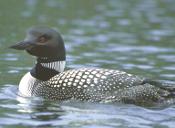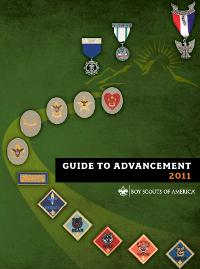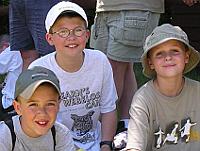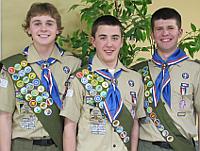Scoutmaster Musings
Archives:
2023 Â 2022 Â 2021 Â 2020 Â 2019 Â 2018 Â 2017 Â 2016 Â 2015 Â 2014 Â 2013 Â 2012 Â 2011 Â 2010 Â 2009 Â 2008 Â 2007 Â 2006 Â 2005 Â
Â
 Here's my sleeping bag replacement for my long hikes starting in the spring. It's a quilt rather than a bag, well, it will be a quilt when I finish.
Here's my sleeping bag replacement for my long hikes starting in the spring. It's a quilt rather than a bag, well, it will be a quilt when I finish.Right now, it's just instructions, a bunch of black yarn, some thread, a few yards of silver grey nylon fabric, and a big bag of polyester insulation. It's up to me to turn it into a 28F sleeping quilt.
Making Your Own Gear (MYOG) is a great way for scouts to reduce the cost of camping equipment, resulting in better, lighter gear. It's a great way to be Thrifty and self-sufficient, as well as learn sewing. Making gear can also be a great patrol or high adventure crew activity.
There are a few items, such as stoves, that aren't acceptable to be homemade in the BSA, and a few other items, like shoes, that don't make sense to MYOG. But, everything else is fair game. I hope to make my own quilt, shelter, pack, food cozy, water pre-filter, and maybe other items for my upcoming long hikes. It should cut about 60% out of my gear cost.
Sleeping quilts may be new to you - they are to me - but if you think of how a sleeping bag works, quilts make sense. You crawl into your sleeping bag on top of your pad and zip up the zipper. The insulation between you and the pad is now squished flat, resulting in no insulating effect. If you were to completely unzip your sleeping bag and lay it over you like a blanket, it would work just as well but would be way too wide.
A quilt is just like a sleeping bag except the heavy zipper is removed and the underbody portion is removed. This results in a much lighter item that lasts longer. It lasts longer because you are not constantly crushing the insulation every time you use it.
Similar to sleeping quilts are top bags which are sleeping bags with insulation only on top and a plain fabric layer on the bottom, or possibly a sleeve into which your sleeping pad fits.
This is my first MYOG project and I'll keep you posted on the results.
Scout On
| Leave Comment |
 You never know what animals, scenery, and cool stuff you might see while hiking or camping. I get excited with the anticipation of seeing something new each morning of a campout, especially when I'm up early before the bugler. It might just be crystals of frost or a foggy sunrise, but there's always something - if you look for it.
You never know what animals, scenery, and cool stuff you might see while hiking or camping. I get excited with the anticipation of seeing something new each morning of a campout, especially when I'm up early before the bugler. It might just be crystals of frost or a foggy sunrise, but there's always something - if you look for it.On highly used paths around communities, it's usually just the squirrels and small chirping birds that I see. They don't really care about humans, but other animals tend to like their privacy and you rarely glimpse them.
The path I hike most mornings is busy. Lately, with the later sunrise and colder temperatures, I've had more time to myself and have seen much more wildlife - a raccoon, buck, red fox, and now an owl. I try to keep my eyes open and I noticed the owl perched on a limb about 40 feet off the trail.
After watching him awhile, I continued on and saw two women walking towards me. When they got closer, I pointed out where they might see the owl if they were interested. I saw that they stopped at the owl for a bit and then continued, so I assume they saw it.
Another group of four very talkative women, two bike riders, and three runners passed me. I didn't bother mentioning the owl to them because they were intent on their own little world, whether that was conversing or covering ground quickly. I expect they were getting what they wanted out of their time on the trail and didn't care if they missed one old bird.
Being out with scouts hiking or camping provides the opportunity to experience many such animal sightings as well as sunrises, scenic vistas, and caterpillars. Often times, a scout group will be more like those people in their own little world - chatting about stuff so loudly animals disappear or zoning out just waiting to get to the end of the day.
That's when a friend (like you) might find ways to share the excitement of what's around. A dead frog, the last leaf hanging on a branch, some bird flying too high to identify, the buckthorn that's the last green bush left before winter, all are small things that could be used to prompt conversation or at least contemplation. "I wonder how long that leaf will hang on?" "How do you think that frog would have survived winter if he didn't get squished?"
Maybe offer a challenge to have each person make up a story about where that high flying bird is going or a legend about 'Why Buckthorn Stays Green'.
Scout hikes allow you to experience a lot, but you have to reach out a bit to find it. If you're hiking along and notice that you're just looking at the ground coming towards you, stop and look up! You're missing out! Well, I'm off to hike 6 miles now - I wonder what I'll see?
Scout On
| Leave Comment |
 Have you seen this sign before?
Have you seen this sign before? It's the ILCOR approved universal AED sign. It indicates the presence of or direction to an AED. ILCOR = International Liaison Committee on Resuscitation. AED = Automated External Defibrillator
Keep your eyes open for these signs whenever you enter a public building and see how many you find. There's a good chance you won't find many in the USA or UK. That's because other signs have been adopted already and are more common. Hopefully, that will change so a universally used symbol will actually be universal, or at least global.
 This is the sign you will likely see to identify AED locations in the USA.
This is the sign you will likely see to identify AED locations in the USA.This weekend, I got to help out a bit at the council's Campmaster Training session. I was asked to speak about recent CPR changes and AED use. All the council camps have AEDs, but there were lots of questions about where to locate them, annual maintenance, and policies.
We also discussed some first aid questions and recent directives about what first aid kit support was required by the camps. I'm afraid I wasn't much help with directives and policies, but the CPR and First Aid discussion was fun.
All adult BSA volunteers should get CPR and AED certification. It's easy and sends a good message to the families in, and considering joining, your unit.
Scout On
| Leave Comment |

A past scout was in town this week so I got to have coffee with him today (well, I had cocoa). Turns out he's heading to New Zealand tomorrow morning, taking a semester off from college to see the world. Good for him!
His plan is to do some hiking and work a couple months on an organic farm for room and board. He needs to be back to start school in January, but other than that his schedule is flexible. He heard about the Rena running aground 14 miles off the coast and may change his plans to see about helping with that clean-up effort.
What a great time of life with few commitments, high hopes, and overflowing enthusiasm. That sense of adventure and exploration is what drives inventors, artists, entrepreneurs, and pretty much all of us to some extent. I'm excited to know this one scout is heading out into the world with just his pack on his back and his head on his shoulders.
I've consistently heard from scouts that their time in the troop really made a difference in how they handle challenges. Whether it's guiding a college backpacking club, studying abroad alone, or leading in the military, they've recalled their outdoor, leadership, and self-sufficiency skills when needed.
That's always good to hear.
Scout On
Challenge Scouts
| Leave Comment |
 I heard and then say the first Loon migrating south on my hike this morning.
I heard and then say the first Loon migrating south on my hike this morning. You can watch individually banded loon migration activity at this USGS page. Over the next month or so, the loons will be heading south to the Gulf of Mexico - smart birds!
Migrations mean that scouts looking to identify plants and animals for advancement are running out of opportunities for the next 5 or 6 months around here. With the leaves off the trees, snow covering the ground, and most animals holed up or basking on southern beaches, it gets very difficult to identify 10 animals and 10 plants.
I believe identifying them is more than pointing to a picture - since the aim of the requirement is to become aware of the surrounding nature, finding the plants and animals for real is how it should be done.
A gentle reminder at the next troop meeting to finish summer time requirements might save a few scouts some frustration over the winter.
Scout On
| Leave Comment |
 On the trail this morning, there was a big dark blob far ahead. In the early morning gloom, I couldn't make it out but it was certainly not there yesterday.
On the trail this morning, there was a big dark blob far ahead. In the early morning gloom, I couldn't make it out but it was certainly not there yesterday.It moved.
Oh, just a rodent, another raccoon scrounging around getting into mischief. But, as I walked closer, it didn't scurry off. As a matter of fact, it looked my way and started coming towards me.
Now, wait a minute. I'm 6-1, 175 pounds and he's 1-2, 20 pounds. Why's he coming at me?
"Hey, go away! Hyah, move it!" Nothing, he just keeps waddling towards me so I start backstepping to keep 20 feet or so between us.
He stopped. I stopped and watched. He kind of teetered and swayed like a drunk trying to stay upright.
Now there's no food that he's protecting. No young ones. I can't see or think of anything that makes his behvior make sense. So, I figure there's something wrong with this guy and I'm not about to get bit or scratched by some zombie raccoon.
Since I was in no hurry, I just watched him. He swayed. He turned. He took a few awkward, uncoordinated steps. I waited.
When he finally got over to the side of this wide trail with his back to me, I quickstepped past him on the other side of the trail. He didn't twitch, budge, or react.
So, how should we interact with animals we meet? We should minimize our impact and respect wildlife according to Leave No Trace principles. If our presence is affecting the animal's behavior then we are too close and should remove ourselves from the area.
Normally, an animal will scurry away from humans, recognizing us as threats. You've probably seen squirrels, chipmunks, birds, snakes, rabbits, maybe even turkey, deer, and fox while out hiking. They will run, fly, or slither away as fast as they can until they feel safe. Sometimes just a few feet to stop and look at you. At that point, our reaction should be to continue down the trail, leaving them alone.
But, if their behavior is inconsistent with what is normally expected then the situation might be dangerous. They may feel threatened and cornered, they may have young to protect, or they may be sick. In those cases, any animal may hold its ground or even attack.
When outdoors, keep your eyes and ears open for animals. If you notice any strange behavior, give ground and move away, probably back the way you came. Keep your eye on the animal. When the aggressive behavior stops or you feel you are a safe distance, watch the animal and make a plan. If you wait long enough, most likely the animal will move off the trail and you can continue.
| Leave Comment |
 I met with our council's Outdoor Ethics Advocate and a couple other Leave No Trace master educators last night to discuss ways in which we might get LNT more integrated into the local Scouting program.
I met with our council's Outdoor Ethics Advocate and a couple other Leave No Trace master educators last night to discuss ways in which we might get LNT more integrated into the local Scouting program.One idea that came up was to have Leave No Trace themed camporees. Rather than trying to convince districts to do this and come up with their own camporee program, it would be easier to get buy-in if a prepared program could be provided, thus cutting down their planning efforts.
So, this morning I went hunting for info. As it turns out, there have been a few such camporees held over the past decade. Here are a few webpages that have such LNT Camporee info, some vague and some with good ideas:
http://leavenotrace.info/wp-content/files/LNT_Fall_Camporee_2005.pdf
http://www.greenwichscouting.org/Calendar/tabid/74/vw/3/itemid/5/d/20110930/Default.aspx
http://www.angelfire.com/ill/wt/PDF/fallcamp04.pdf
http://www.housatonicbsa.org/Camping/Camporee/2009SpringCamporeeHandout.pdf
http://www.nonprofitpages.com/muirdistrict/camporee/2005CamporeeProgram.pdf
http://www.boyscoutsla.org/website/Frontier/Events/2011_Fall_Camporee_Packet.pdf
https://1bsa.org/tyfoon/site/fckeditor/file/Mtn%20Lakes%20Spring%202011%20Camporee.pdf
http://troop693.wdfiles.com/local:files/camporee-april-2009/camporee09.pdf
http://leavenotrace.info/wp-content/files/LNT_Camporee_Outline.PDF
http://troop693.wdfiles.com/local:files/camporee-april-2009/camporee09.pdf
Have you been to an LNT Camporee? How was it? If you can send me a document of the activities, contests, or program, that would be great!
Scout On
| See 1 comment | Leave Comment |
 The 2011 Guide to Advancement is ready. It has a few significant changes and gives individual units more room to define their own expectations:
The 2011 Guide to Advancement is ready. It has a few significant changes and gives individual units more room to define their own expectations:- Active Participation requirements updated. Units can set their own 'active' expectations.
- Position of Responsibility requirements updated. Units can set expectations to define the fulfillment of the position.
- Merit badge section revampd.
- Info about wearing uniform to Board of Review clarified - uniforms can not be mandatory.
- Changes in the Eagle Scout Service Project requirement.
- Awards and recognitions moved to a separate Guide to Awards and Insignia.
Councils may choose to make a transition over the next few months from the former advancement publication to the new Guide to Advancement. After January 1, however, the new guide must be consulted for all advancement procedures.
It would be a good idea to get this new document into the hands of your unit committee chair, advancement chair, and scoutmaster/advisor/cubmaster as soon as you can.
Download 2011 Guide to Advancement - 4.5MB PDF
Scout On
| Leave Comment |
 Yesterday was almost the last day for a German vistor hiking the White Mountains in New Hampshire. He apparently suffered a heart attack on the trail and went down. Fortunately, he is in a hospital in stable condition instead of a morgue today.
Yesterday was almost the last day for a German vistor hiking the White Mountains in New Hampshire. He apparently suffered a heart attack on the trail and went down. Fortunately, he is in a hospital in stable condition instead of a morgue today.Another German tourist, not with the first, came by just moments later and began CPR. While CPR was being given, other hikers raced to the trailhead where they found a person with a cellphone. She called for help.
When an ambulance crew arrived, they revived him with their portable defibrillator and rushed him to the hospital.
Similar scenarios unfold every day. In just the past two weeks, hikers died in AR, CA, CO, ME, NH, NY, OR, and WA according to a google search. 20 people have died in Yosemite Natl Park alone this year.
If you come upon an injured hiker, would you know what to do? First Aid and CPR skills are overlooked by many that venture into the wilds. Be able to care for yourself, others in your group, and victims you may encounter - get some training.
Win $500 Camping Gear
| Leave Comment |
This is a Sponsored post written by me on behalf of Boy Scouts of America for SocialSpark. All opinions are 100% mine.
Joining the Boy Scouts of America is the best way to expand a boy's social, physical, and personal health and skills. I know and believe this wholeheartedly from seeing it happen day after day for a dozen years now.
Here's an example: These three little guys joined a Boy Scout troop 6 years ago. They each got a Scout Handbook and learned a wide range of useful life skills, such as swimming, cooking, and first aid. They also learned cool outdoors skills, like camping, hiking, navigating, and astronomy.
These three little guys joined a Boy Scout troop 6 years ago. They each got a Scout Handbook and learned a wide range of useful life skills, such as swimming, cooking, and first aid. They also learned cool outdoors skills, like camping, hiking, navigating, and astronomy.
More importantly, they worked together all the time, learning how a team needs leaders and followers to be successful. Each of them had opportunities to both follow and lead.
As they went on campouts, participated in meetings, and earned awards, they passed their knowledge onto the younger scouts that joined after them. This mentoring is the main way a troop lives - it's a cycle that repeats over the years.
 I just attended the Eagle Scout ceremony for these same three boys. Six years after becoming Boy Scouts, they had grown into strong, young men. They took advantage of all the Scouting opportunities for exploring the wilds, challenging themselves, and developing their leadership skills to reach this milestone.
I just attended the Eagle Scout ceremony for these same three boys. Six years after becoming Boy Scouts, they had grown into strong, young men. They took advantage of all the Scouting opportunities for exploring the wilds, challenging themselves, and developing their leadership skills to reach this milestone.
Their time in Boy Scouts provided a well-rounded experience, not only physical development or only mental development as can happen with sports or academics. Scouting provided them with an extremely wide range of challenges so they could strengthen their existing abilities and expand their breadth of skills.
It's not a coincidence that you hear so many famous and successful Americans were Boy Scouts. Take a peek at this list of Eagle Scouts. There's no reason a boy you know can't someday be on that list.
Last night, I attended another Eagle ceremony. It was for a scout across town in a different troop. Every troop does things a bit differently so I wanted to see how this troop ran its ceremonies.
It was great to see the audience had boys ranging from 6 years old to 18 years old, as well as many adults in Scouting uniforms. Much of the ceremony was directed at the younger scouts, encouraging them to have fun in Scouting and someday become an Eagle as well. This encouragement from older scouts to younger is a common theme and one of my favorite parts of Scouting.
The part of the ceremony I enjoyed the most was watching the color guard retire the flags. It was made up of a Cub Scout from each rank - Tiger, Wolf, Bear, Webelos - and you could see how nervous and proud they were as they bravely walked to the front, retrieved the flags, and carried them out. These were elementary school boys in front of an audience of 150 or so people.
Every boy should be a Scout and the easiest way to get started is to visit the Be A Scout website to find a pack or troop in your town.
Participation in Scouting helps a boy in many ways:
- Physical Fitness - getting into the outdoors and away from the video games
- Citizenship - leadership skills and respect for others prepares scouts to contribute to their community
- Character - opportunities to make decisions and choices build the boy's maturity, morality, and bravery to handle difficult choices in the world
Camping Gear Contest
You could win a way cool camping package in the Go Camping with the Boy Scouts of America contest. Read the contest rules and then enter. All you need to do is:
- Leave a comment on this blog post explaining why you think its beneficial for a child to become a Scout Â
And/Or - Tweet out a message that links back to this blog post and contains the hashtag #beascout
Scout On
| Leave Comment |

I'm going to an Eagle court of honor this evening. It's for a terrific scout in a different troop than my son. He's been highly active in OA and a great scout. He has contributed tons of time and effort to Scouting in our district.
So, I was wondering if boys who stay in Scouting longer actually contribute more to society than the average Joe, why is that so? Did Scouting make them into what they are, OR do they make Scouting into what it is?
I've seen a wide range of guys join the troop, from every ethnic background, financial status, popularity level, and personality profile in our community. Every year, a few of the new guys will stop participating after a few months. When asked, it is usually because they were too busy doing other things - but an occasional honest reply will be that the boy was just trying it out and decided Scouting was not his deal.
Over the next few years, some scouts will stop participating and will usually tell me their honest reasons - sports priority, lost interest in camping, got new friends.
That leaves the guys that advance through the ranks, usually to Eagle; the guys that do high adventures; the guys that run the show; the guys I think of when I think 'Boy Scouts'. These guys stay to the end and are the ones we use as examples. But, did Scouting do that to them or would they be that way anyway?
As I've watched these guys mature, learn skills, and become leaders, I've come to believe that Scouting is just a big piece of canvas.

What do you think would happen if you gave 50 people each a canvas, brush, and paints and asked them to paint something interesting? Some would cover the canvas in a single coat. Others would make stick figures. Some would make a nice picture. A couple might create artistic masterpieces.
Give them a new canvas and ask them to do it again. I'd expect the pictures would improve.
Give them another canvas and with practice the pictures improve for most of them, but there would be some that reached their limit with stick figures. They may not be good artists, but the canvas gives them the opportunity to practice, improve, and discover.
Just like the canvas gives the artist a place to explore, imagine, create, make mistakes, and safely try new things, Scouting provides many opportunities for the boy to make decisions, see results of his efforts, and modify his style in a safe community.
Through that practice, he grows into a better person than he would have been without the practice.
Scout On
| Leave Comment |

Hey, Scouts!
Three days to enter this way cool Land of Adventure Boys Life contest. You could win it all, but at least get a free patch for entering!
Check out Boys Life Contests for a half dozen other contests going on at the BSA.
Scout On
| Leave Comment |
Comments:
Â
Feb 25, 2023 - Joe Patterson
Mar 16, 2023 - Adam John
Jan 21, 2024 - Johnna Downing
Scouting 2024  -  Ask a Question  -  Add Content
Just for Fun: Socializing merit badge




Â
Â
Â
Â
Find more Scouting Resources at www.BoyScoutTrail.com



 Follow Me, Scouts
Recent Comments